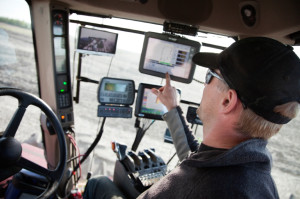Benefits of Precision Agriculture
 With all the new advances in agriculture cropping up over the last several years—whether it’s advances in equipment or developments in seed hybrids—perhaps none is doing more to change the farming landscape than the advent of precision agriculture. Farmers across the nation are turning toward this technological innovation, and are readily seeing its myriad benefits to their farming operations.
With all the new advances in agriculture cropping up over the last several years—whether it’s advances in equipment or developments in seed hybrids—perhaps none is doing more to change the farming landscape than the advent of precision agriculture. Farmers across the nation are turning toward this technological innovation, and are readily seeing its myriad benefits to their farming operations.
Precision agriculture, also known as site-specific farming, is made possible by combining the Global Positioning System (GPS) and the geographic information system (GIS). By uniting these two systems, it is possible to analyze, interpret, and manipulate large amounts of geospatial data with efficiency and in real time. Farmers are applying this technology—in whole or in part—to nearly every aspect of their farms, including farm planning, field mapping, soil sampling, tractor guidance, crop scouting, variable rate applications, and yield mapping.
What are the potential benefits of adding precision technology to your farm? Naturally, there is a strong economic advantage: Precision technology enables users to increase their farm ROI. This comes from a combination of better efficiency at planting to greater yields at harvest, as well as more effective applications during the growing season. What’s more, it is apparent that these economic advantages are made manifest in a short amount of time—often in the first year.
In addition to greater ROI, farmers who have adopted precision ag technologies in their operations report other benefits. For example, autosteer in tractors and combines lowers stress on both shoulders and minds, as operators are able to pay more attention to what is going on over the whole field, rather than focusing intently on driving in a straight line.
Experienced users of precision technology on their farms will admit to a certain degree of skepticism at first, both in regard to the initial investment and the overall perception of need. However, the cost savings combined with the other more tangential benefits readily eradicate any initial uncertainty. Experts in the field and farmers themselves will admit that one needn’t go “whole hog” when adopting these systems on their farms. Often, taking it step by step is the best and least stressful way of incorporating these technologies. A great example of this is in seed control—an area that has seen significant cost increases. Implementing precision technology in this area alone could cut down on overlap during planting and offer significant savings.
Naturally, technology moves quickly, and even more exciting innovations in precision agriculture are on the horizon. One such advancement is with planters—including high speed planters and multi hybrid planters, which will allow farmers to micromanage their fields at small areas that would have seemed impossible 10 years ago. These multi hybrid planters will enable farmers to plant a suitable hybrid for each portion of their field, thereby increasing their yields and profitability.
Are you looking to incorporate precision technology on your farm and are not sure where to start? Let the experts at UFARM offer a helping hand. We’ll do all we can to help you choose the best way to optimize your farming operation.
United Farm and Ranch Management (UFARM) is a Nebraska-based company devoted to meeting landowners’ needs. UFARM offers a full range of Nebraska land management services, including real estate sales, rural property appraisals, consultations and crop insurance. UFARM has operated in Nebraska since the early 1930’s.
Sources:
“Agriculture Applications.” GPS.gov. 27 Sep. 2013. Web. 28 Jun. 2014.
Johnson, Jan. “Precision Agriculture: Higher Profit, Lower Cost.” Precision AgWorks. PrecisionAg.com. 01 Nov. 2012. Web. 28 Jun. 2014.
Scott, Jessie. “The Planter of the Future is Here.” Agriculture. Agriculture.com. 15 Jun. 2014.Web. 28 Jun. 2014.

